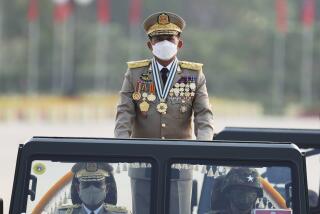Former Headhunters on Burma’s Border Seek Independence
- Share via
NAGA HILLS, Burma — Kaita does not know how old he is, but he thinks he must be around 60 or 70. “But I became a Christian in 1982,” he says. “That was in the same year as we gave up headhunting.”
This area of northwestern Burma on the Patkai Range is one of Southeast Asia’s last frontiers, and the memory of taking enemy heads is still fresh to a people who discovered the Iron Age only this century.
For centuries, Nagas tribes had lived in isolation in the remote hills on both sides of the Patkai Range on the Burma-India border, largely unaware of the world around them until American Baptist missionaries began preaching to the Nagas on Indian side of the range toward the end of the 19th Century.
Considered Wild Territory
On the Burmese side, however, the eastern hills remained unadministered territory during British rule and even Burma, since its independence in 1948, has not attempted to extend its control beyond the few towns in the area.
Even to the more civilized Nagas on the Indian side, the international frontier was wild territory that few had visited.
British anthropologist John H. Hutton wrote in 1929: “It is in this unknown country that the western tribes locate villages of Amazons, ogresses and cannibals of which their legends tell.”
Christianity came to the eastern Naga indirectly as a result of a longstanding war between the western Nagas and the Indian Army.
Fighting Continued
The Nagas on the Indian side resorted to armed struggle in 1956 to press their demands for independence from New Delhi, claiming that their being a part of India was a result of colonialism and that they had nothing in common with the Indo-Aryan majority in the subcontinent.
Fighting between the Indian Army and Naga guerrillas continued until the mid-1970s, when sustained army operations in the western hills drove the Naga across the border into the country of their cousins on the Burmese side.
The Naga guerrillas brought with them their arms and ammunition--and their Bibles.
They pacified the Nagas of the eastern hills, put an end to headhunting and quickly introduced Christianity.
Ideology a Curious Blend
And it is from these remote, well-sheltered sanctuaries that the Naga guerrillas, who call themselves the National Socialist Council of Nagaland, hope to carve out an independent state, comprising the Naga-inhabited areas of both India and Burma.
Their ideology is a curious blend of evangelical Christianity and revolutionary Socialism, which the Nagas got in the early 1970s when they trekked to China to receive arms and military training. Chinese support for the Nagas’ struggle against India ceased, however, after the death of Mao Tse-tung and the subsequent shifts in Beijing’s foreign policy.
But the Nagas have not given up their dream of an independent country, as Thuingaleng Muivab, general secretary of the National Socialist Council of Nagaland explained in an interview.
“Our goal is a sovereign, Christian, socialist country. We stand for socialism because it is the only social and economic system that does away with exploitation,” he said.
‘Arms Will Save Our Nation’
“We also stand for the faith in God and salvation of mankind in Jesus, that is Nagaland for Christ. And we rule out the illusion of saving Nagaland through peaceful means. It is arms and arms again that will save our nation and ensure freedom to the people.”
While Christianity, or more precisely the concept of an almighty power, can be easily comprehended by people such as Kaita, the ideas of socialism and even independence appear much harder for them to grasp.
“Independence? What is that? We have always ruled ourselves,” said Kaita who was the headman of a cluster of 15 villages that had been fortified with stockades, watchtowers and trenches filled with sharpened bamboo stakes as protection against their enemies.
The Naga insurgency against India has managed to survive in these Burmese sanctuaries, political analysts say, because the Rangoon government is fighting on fronts elsewhere in the country--against more immediate dangers posed by Karen, Kachin, Shan and other rebel groups.
Approach Is the Key
“The greatest danger to the National Socialist Council of Nagaland’s future is the possibility of Rangoon adopting a political instead of military approach to its internal insurgency problems,” one observer said.
India, meanwhile, can do little more than watch helplessly as the situation in their part of the Naga Hills deteriorate.
And for Kaita and the others, life will go on as usual: a struggle for survival only interrupted by National Socialist Council of Nagaland-organized prayer meetings and, in private, nostalgic talks about the bygone days when they went on the warpath in search of enemy heads.
More to Read
Sign up for Essential California
The most important California stories and recommendations in your inbox every morning.
You may occasionally receive promotional content from the Los Angeles Times.













